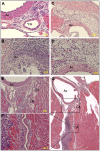Augmented TLR2 expression on monocytes in both human Kawasaki disease and a mouse model of coronary arteritis
- PMID: 22737215
- PMCID: PMC3380902
- DOI: 10.1371/journal.pone.0038635
Augmented TLR2 expression on monocytes in both human Kawasaki disease and a mouse model of coronary arteritis
Abstract
Background: Kawasaki disease (KD) of unknown immunopathogenesis is an acute febrile systemic vasculitis and the leading cause of acquired heart diseases in childhood. To search for a better strategy for the prevention and treatment of KD, this study compared and validated human KD immunopathogenesis in a mouse model of Lactobacillus casei cell wall extract (LCWE)-induced coronary arteritis.
Methods: Recruited subjects fulfilled the criteria of KD and were admitted for intravenous gamma globulin (IVIG) treatment at the Kaohsiung Chang Gung Memorial Hospital from 2001 to 2009. Blood samples from KD patients were collected before and after IVIG treatment, and cardiovascular abnormalities were examined by transthoracic echocardiography. Wild-type male BALB/c mice (4-week-old) were intraperitoneally injected with LCWE (1 mg/mL) to induce coronary arteritis. The induced immune response in mice was examined on days 1, 3, 7, and 14 post injections, and histopathology studies were performed on days 7 and 14.
Results: Both human KD patients and LCWE-treated mice developed coronary arteritis, myocarditis, valvulitis, and pericarditis, as well as elevated plasma levels of interleukin (IL)-2, IL-6, IL-10, monocyte chemoattractant protein (MCP)-1, and tumor necrosis factor (TNF)-α in acute phase. Most of these proinflammatory cytokines declined to normal levels in mice, whereas normal levels were achieved in patients only after IVIG treatment, with a few exceptions. Toll-like receptor (TLR)-2, but not TLR4 surface enhancement on circulating CD14+ monocytes, was augmented in KD patients before IVIG treatment and in LCWE-treated mice, which declined in patients after IVIG treatment.
Conclusion: This result suggests that that not only TLR2 augmentation on CD14+ monocytes might be an inflammatory marker for both human KD patients and LCWE-induced CAL mouse model but also this model is feasible for studying therapeutic strategies of coronary arteritis in human KD by modulating TLR2-mediated immune activation on CD14+ monocytes.
Conflict of interest statement
Figures





References
-
- Kawasaki T, Kosaki F, Okawa S, Shigematsu I, Yanagawa H. A new infantile acute febrile mucocutaneous lymph node syndrome (MLNS) prevailing in Japan. Pediatrics. 1974;54:271–276. - PubMed
-
- Barron KS. Kawasaki disease in children. Curr Opin Rheumatol. 1998;10:29–37. - PubMed
-
- Taubert KA, Rowley AH, Shulman ST. Seven-year national survey of Kawasaki disease and acute rheumatic fever. Pediatr Infect Dis J. 1994;13:704–708. - PubMed
-
- Nakamura Y, Yashiro M, Uehara R, Oki I, Kayaba K, et al. Increasing incidence of Kawasaki disease in Japan: nationwide survey. Pediatr Int. 2008;50:287–290. - PubMed
-
- Suzuki A, Miyagawa-Tomita S, Komatsu K, Nishikawa T, Sakomura Y, et al. Active remodeling of the coronary arterial lesions in the late phase of Kawasaki disease: immunohistochemical study. Circulation. 2000;101:2935–2941. - PubMed
Publication types
MeSH terms
Substances
LinkOut - more resources
Full Text Sources
Medical
Research Materials
Miscellaneous

